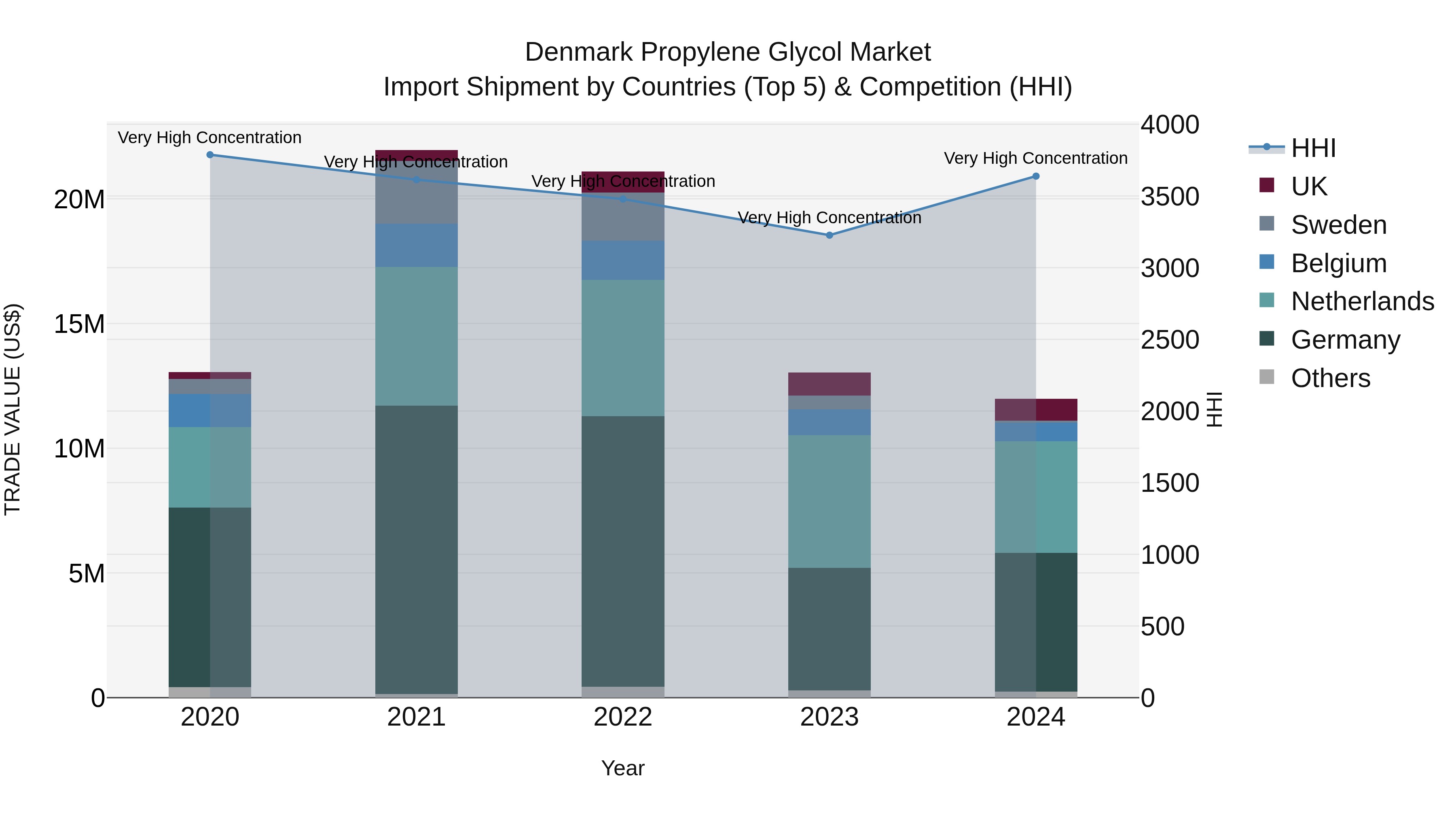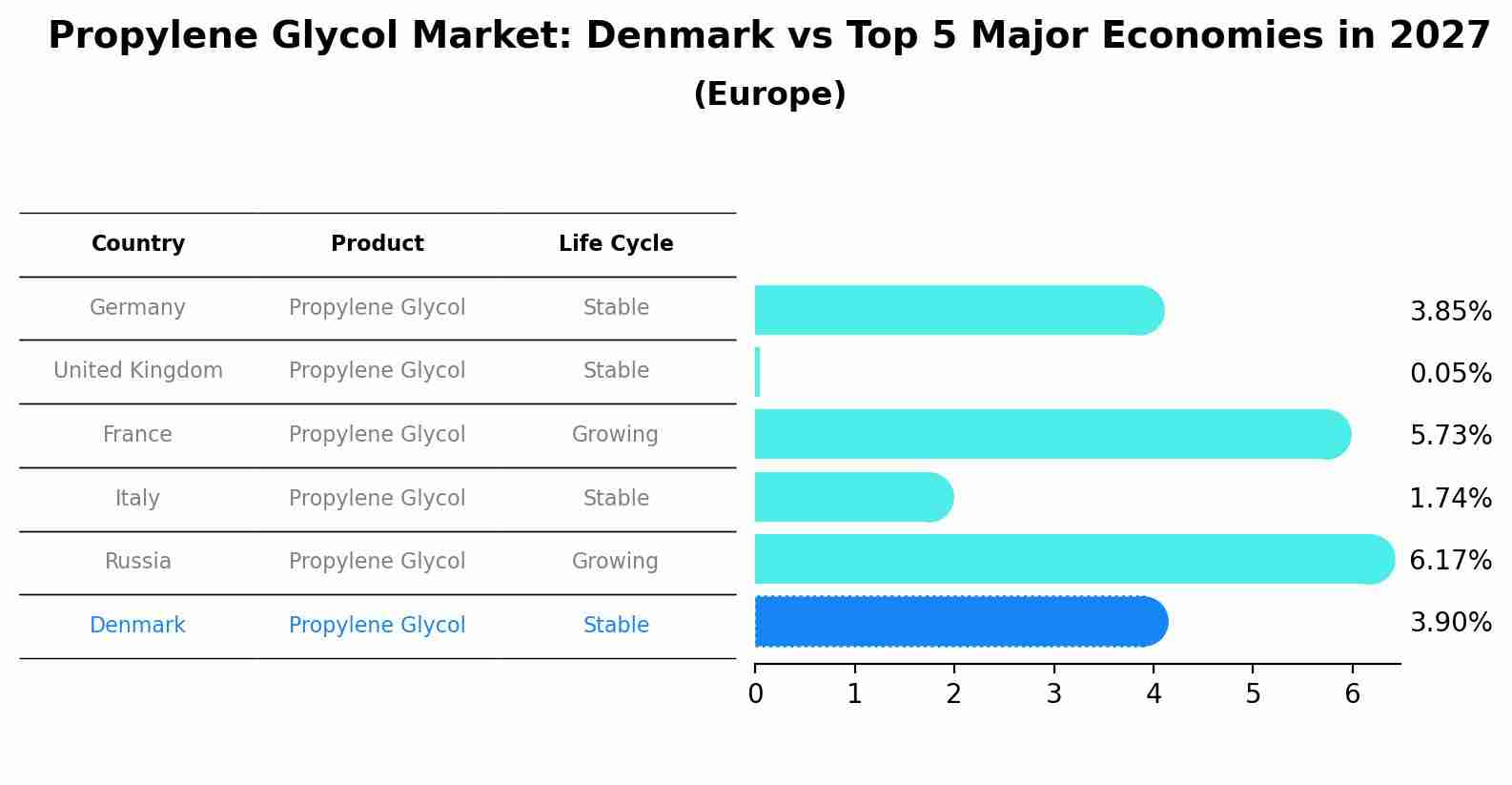Denmark Propylene Glycol Market (2025-2031) | Companies, Value, Size, Revenue, Trends, Segmentation, Industry, Analysis, Forecast, Share, Growth & Outlook
| Product Code: ETC5358728 | Publication Date: Nov 2023 | Updated Date: Dec 2025 | Product Type: Market Research Report | |
| Publisher: 6Wresearch | Author: Bhawna Singh | No. of Pages: 60 | No. of Figures: 30 | No. of Tables: 5 |
Denmark Propylene Glycol Market Top 5 Importing Countries and Market Competition (HHI) Analysis
Denmark propylene glycol import market continued to be dominated by key suppliers such as Germany, Netherlands, UK, Belgium, and Poland in 2024. Despite a negative Compound Annual Growth Rate (CAGR) of -2.13% from 2020 to 2024, the market experienced a significant decline in growth rate of -8.03% from 2023 to 2024. The high Herfindahl-Hirschman Index (HHI) indicates a concentrated market structure, potentially leading to challenges in terms of competition and pricing dynamics for importers in Denmark. Monitoring trends and developments in these key supplier countries will be crucial for market participants in the coming years.

Propylene Glycol Market: Denmark vs Top 5 Major Economies in 2027 (Europe)
By 2027, Denmark's Propylene Glycol market is forecasted to achieve a stable growth rate of 3.90%, with Germany leading the Europe region, followed by United Kingdom, France, Italy and Russia.

Denmark Propylene Glycol Market Overview
The Denmark propylene glycol market is characterized by its diverse applications across multiple industries, including food, pharmaceuticals, and cosmetics. Propylene glycol is favored for its low toxicity and versatile properties, making it a popular choice as a solvent, humectant, and emulsifier. The market has seen steady growth, driven by increasing demand for propylene glycol in food and beverage applications as a safe additive, particularly in bakery and dairy products. Furthermore, the pharmaceutical sector utilizes propylene glycol for drug formulations and as an excipient. The rise of eco-friendly practices has also led to a growing interest in bio-based propylene glycol alternatives, which may shape the market`s future dynamics as manufacturers seek to align with sustainability trends.
Drivers of the market
The propylene glycol market in Denmark is primarily driven by its increasing applications in various industries such as pharmaceuticals, food, and cosmetics. Its role as a humectant and stabilizer makes it a critical ingredient in personal care products, leading to a steady demand. Additionally, the growing use of propylene glycol as an antifreeze and de-icing fluid, particularly in Denmark`s cold climate, further fuels the market. The increasing shift toward bio-based propylene glycol, due to environmental concerns, is also encouraging growth in the market.
Challenges of the market
The Denmark propylene glycol market faces significant challenges related to environmental regulations and sustainability. Increasingly stringent regulations regarding the use of synthetic chemicals and the push for greener alternatives hinder the growth of propylene glycol derived from petroleum sources. Moreover, competition from bio-based alternatives is on the rise, compelling manufacturers to invest in research and development to innovate and create eco-friendly products. Supply chain disruptions, particularly due to geopolitical tensions and fluctuations in crude oil prices, further complicate market dynamics. These factors combined make it difficult for companies to maintain competitive pricing while adhering to regulatory standards.
Government Policy of the market
In Denmark, the production and use of propylene glycol are influenced by stringent environmental regulations due to its potential environmental impact. Danish policies focusing on reducing carbon emissions and promoting sustainable chemicals have led to an increased focus on bio-based propylene glycol production. The government supports research and innovation in green chemistry through grants and tax incentives, which are crucial for local producers to transition towards eco-friendly processes.
Key Highlights of the Report:
- Denmark Propylene Glycol Market Outlook
- Market Size of Denmark Propylene Glycol Market, 2024
- Forecast of Denmark Propylene Glycol Market, 2031
- Historical Data and Forecast of Denmark Propylene Glycol Revenues & Volume for the Period 2021-2031
- Denmark Propylene Glycol Market Trend Evolution
- Denmark Propylene Glycol Market Drivers and Challenges
- Denmark Propylene Glycol Price Trends
- Denmark Propylene Glycol Porter`s Five Forces
- Denmark Propylene Glycol Industry Life Cycle
- Historical Data and Forecast of Denmark Propylene Glycol Market Revenues & Volume By Application for the Period 2021-2031
- Historical Data and Forecast of Denmark Propylene Glycol Market Revenues & Volume By Unsaturated Polyester Resins,Functional Fluids,Food, Drug, and Cosmetics,Liquid Detergent,Paints and Coating,Others for the Period 2021-2031
- Denmark Propylene Glycol Import Export Trade Statistics
- Market Opportunity Assessment By Application
- Denmark Propylene Glycol Top Companies Market Share
- Denmark Propylene Glycol Competitive Benchmarking By Technical and Operational Parameters
- Denmark Propylene Glycol Company Profiles
- Denmark Propylene Glycol Key Strategic Recommendations
Frequently Asked Questions About the Market Study (FAQs):
1 Executive Summary |
2 Introduction |
2.1 Key Highlights of the Report |
2.2 Report Description |
2.3 Market Scope & Segmentation |
2.4 Research Methodology |
2.5 Assumptions |
3 Denmark Propylene Glycol Market Overview |
3.1 Denmark Country Macro Economic Indicators |
3.2 Denmark Propylene Glycol Market Revenues & Volume, 2021 & 2031F |
3.3 Denmark Propylene Glycol Market - Industry Life Cycle |
3.4 Denmark Propylene Glycol Market - Porter's Five Forces |
3.5 Denmark Propylene Glycol Market Revenues & Volume Share, By Application, 2021 & 2031F |
4 Denmark Propylene Glycol Market Dynamics |
4.1 Impact Analysis |
4.2 Market Drivers |
4.2.1 Increasing demand for propylene glycol in the food and beverage industry due to its use as a solvent, emulsifier, and humectant. |
4.2.2 Growing awareness about the benefits of propylene glycol in pharmaceutical applications such as oral medications, topical formulations, and injections. |
4.2.3 Rising adoption of propylene glycol in personal care and cosmetics products for its moisturizing and solvent properties. |
4.3 Market Restraints |
4.3.1 Fluctuating prices of raw materials used in propylene glycol production, such as petroleum and natural gas. |
4.3.2 Stringent regulations on the use of propylene glycol in certain industries, impacting market growth. |
5 Denmark Propylene Glycol Market Trends |
6 Denmark Propylene Glycol Market Segmentations |
6.1 Denmark Propylene Glycol Market, By Application |
6.1.1 Overview and Analysis |
6.1.2 Denmark Propylene Glycol Market Revenues & Volume, By Unsaturated Polyester Resins,? Functional Fluids,? Food, Drug, and Cosmetics,? Liquid Detergent,? Paints and Coating,? Others, 2021-2031F |
7 Denmark Propylene Glycol Market Import-Export Trade Statistics |
7.1 Denmark Propylene Glycol Market Export to Major Countries |
7.2 Denmark Propylene Glycol Market Imports from Major Countries |
8 Denmark Propylene Glycol Market Key Performance Indicators |
8.1 Adoption rate of propylene glycol in new applications and industries. |
8.2 Number of research and development activities focused on enhancing the properties and applications of propylene glycol. |
8.3 Environmental sustainability initiatives undertaken by propylene glycol manufacturers in Denmark. |
9 Denmark Propylene Glycol Market - Opportunity Assessment |
9.1 Denmark Propylene Glycol Market Opportunity Assessment, By Application, 2021 & 2031F |
10 Denmark Propylene Glycol Market - Competitive Landscape |
10.1 Denmark Propylene Glycol Market Revenue Share, By Companies, 2024 |
10.2 Denmark Propylene Glycol Market Competitive Benchmarking, By Operating and Technical Parameters |
11 Company Profiles |
12 Recommendations | 13 Disclaimer |
- Single User License$ 1,995
- Department License$ 2,400
- Site License$ 3,120
- Global License$ 3,795
Search
Thought Leadership and Analyst Meet
Our Clients
Related Reports
- Afghanistan Apparel Market (2026-2032) | Growth, Outlook, Industry, Segmentation, Forecast, Size, Companies, Trends, Value, Share, Analysis & Revenue
- Canada Oil and Gas Market (2026-2032) | Share, Segmentation, Value, Industry, Trends, Forecast, Analysis, Size & Revenue, Growth, Competitive Landscape, Outlook, Companies
- Germany Breakfast Food Market (2026-2032) | Industry, Share, Growth, Size, Companies, Value, Analysis, Revenue, Trends, Forecast & Outlook
- Australia Briquette Market (2025-2031) | Growth, Size, Revenue, Forecast, Analysis, Trends, Value, Share, Industry & Companies
- Vietnam System Integrator Market (2025-2031) | Size, Companies, Analysis, Industry, Value, Forecast, Growth, Trends, Revenue & Share
- ASEAN and Thailand Brain Health Supplements Market (2025-2031) | Strategy, Consumer Insights, Analysis, Investment Trends, Opportunities, Growth, Size, Share, Industry, Revenue, Segments, Value, Segmentation, Supply, Forecast, Restraints, Outlook, Competition, Drivers, Trends, Demand, Pricing Analysis, Competitive, Strategic Insights, Companies, Challenges
- ASEAN Bearings Market (2025-2031) | Strategy, Consumer Insights, Analysis, Investment Trends, Opportunities, Growth, Size, Share, Industry, Revenue, Segments, Value, Segmentation, Supply, Forecast, Restraints, Outlook, Competition, Drivers, Trends, Demand, Pricing Analysis, Competitive, Strategic Insights, Companies, Challenges
- Europe Flooring Market (2025-2031) | Outlook, Share, Industry, Trends, Forecast, Companies, Revenue, Size, Analysis, Growth & Value
- Saudi Arabia Manlift Market (2025-2031) | Outlook, Size, Growth, Trends, Companies, Industry, Revenue, Value, Share, Forecast & Analysis
- Uganda Excavator, Crane, and Wheel Loaders Market (2025-2031) | Strategy, Consumer Insights, Analysis, Investment Trends, Opportunities, Growth, Size, Share, Industry, Revenue, Segments, Value, Segmentation, Supply, Forecast, Restraints, Outlook, Competition, Drivers, Trends, Demand, Pricing Analysis, Competitive, Strategic Insights, Companies, Challenges
Industry Events and Analyst Meet
Whitepaper
- Middle East & Africa Commercial Security Market Click here to view more.
- Middle East & Africa Fire Safety Systems & Equipment Market Click here to view more.
- GCC Drone Market Click here to view more.
- Middle East Lighting Fixture Market Click here to view more.
- GCC Physical & Perimeter Security Market Click here to view more.
6WResearch In News
- Doha a strategic location for EV manufacturing hub: IPA Qatar
- Demand for luxury TVs surging in the GCC, says Samsung
- Empowering Growth: The Thriving Journey of Bangladesh’s Cable Industry
- Demand for luxury TVs surging in the GCC, says Samsung
- Video call with a traditional healer? Once unthinkable, it’s now common in South Africa
- Intelligent Buildings To Smooth GCC’s Path To Net Zero


















